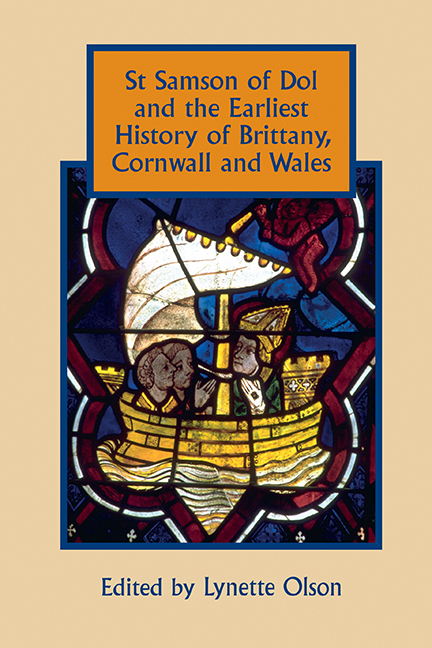Book contents
- Frontmatter
- Contents
- List of Tables
- Editor's Preface
- Map: Places associated with St Samson in the First Life
- 1 Introduction: ‘Getting Somewhere’ with the First Life of St Samson of Dol
- 2 A Family and its Saint in the Vita Prima Samsonis
- 3 La Circulation de l'information dans la Vie ancienne de s. Samson de Dol et la question de sa datation
- 4 The Hare and the Tortoise? Vita Prima Sancti Samsonis, Vita Paterni, and Merovingian Hagiography
- 5 Columbanus, the Britons, and the Merovingian Church
- 6 Apostolic Authority and Celtic Liturgies: from the Vita Samsonis to the Ratio de cursus
- 7 The Representation of Early British Monasticism and Peregrinatio in Vita Prima S. Samsonis
- 8 Present and Yet Absent: the Cult of St Samson of Dol in Wales
- Bibliography
- Index
- Studies in Celtic History
3 - La Circulation de l'information dans la Vie ancienne de s. Samson de Dol et la question de sa datation
Published online by Cambridge University Press: 05 July 2018
- Frontmatter
- Contents
- List of Tables
- Editor's Preface
- Map: Places associated with St Samson in the First Life
- 1 Introduction: ‘Getting Somewhere’ with the First Life of St Samson of Dol
- 2 A Family and its Saint in the Vita Prima Samsonis
- 3 La Circulation de l'information dans la Vie ancienne de s. Samson de Dol et la question de sa datation
- 4 The Hare and the Tortoise? Vita Prima Sancti Samsonis, Vita Paterni, and Merovingian Hagiography
- 5 Columbanus, the Britons, and the Merovingian Church
- 6 Apostolic Authority and Celtic Liturgies: from the Vita Samsonis to the Ratio de cursus
- 7 The Representation of Early British Monasticism and Peregrinatio in Vita Prima S. Samsonis
- 8 Present and Yet Absent: the Cult of St Samson of Dol in Wales
- Bibliography
- Index
- Studies in Celtic History
Summary
English summary: The Diffusion of Information in the Early Life of St Samson of Dol and the Question of its Date
This study aims to re-examine the difficult and still uncertain date of the First Life of St Samson of Dol (BHL 7478–79). Several generations of philologists and historians have tried to specify its date; the solutions so far proposed have been very different, as much in their chronological range (from the beginning of the seventh century to the beginning of the ninth century) as in the diversity of means employed (linguistic, literary, contextual). The issue is significant because the First Life is the first to have influenced much of the Breton hagiography of the second half of the ninth century. Further, the date of this work conditions the use to which it can be put as witnessing the history of regions of British population on both sides of the Channel in the early middle ages.
The present essay extends a series of attempts through which I have sought to resolve the chronological uncertainty of this key document. After exploiting formal and typological parallels with the Vita S. Martini of Sulpicius Severus (in 1977), then using a table of chapters as a tool for distinguishing two layers of the text (in 2001), I now embark on analysing the Vita as a system of information. The starting hypothesis draws on the presence of traces of reworking which raise the possibility that we might be dealing with the rewriting of an earlier text (the so-called *Vita primigenia).
Three approaches are employed in turn in order to specify the relationship between means of writing and dating of the text. Firstly, numerous individuals mentioned in the text are re-situated on a virtual chronological time-line as sources of information: the saint himself, his mother Anna, his cousin Henoc, the latter's nephew and finally a writer of Dol. This chain of mediators can hardly stretch beyond the end of the seventh century, even supposing great longevity for each of them. But it has to be acknowledged that such a chronological chain, on its own, is not very solid.
A second approach is to reconstitute the stages of a progressive elaboration of the dossier of St Samson. How did the redactor(s) gather and shape the traditions about the saint, oral as much as written? Measured from this perspective, the contributions of the two supposed authors do not have the same documentary value.
- Type
- Chapter
- Information
- Publisher: Boydell & BrewerPrint publication year: 2018



